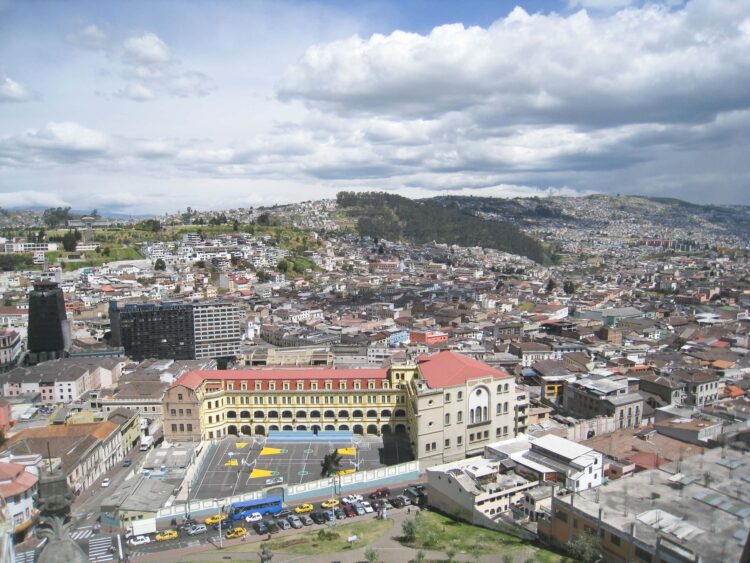
Quito, Ecuador
Quito is the capital of Ecuador, a UNESCO World Heritage site, and the principal city through which tourists arrive and depart the country.
For those who still make the mistake of skipping Colombia, Quito continues to be a popular start or end point for backpackers traveling the South America circuit.
Located at an altitude of 2,850 meters (10,000 feet), Quito is also one of the world's highest capital cities.
In South America, it's also one of the cheapest, after La Paz in Bolivia.
While the city itself isn't the prettiest, nor the safest, there are enough interesting and unique activities to keep visitors busy for at least a few days, before moving on to either the Galapagos Islands or other parts of the country.
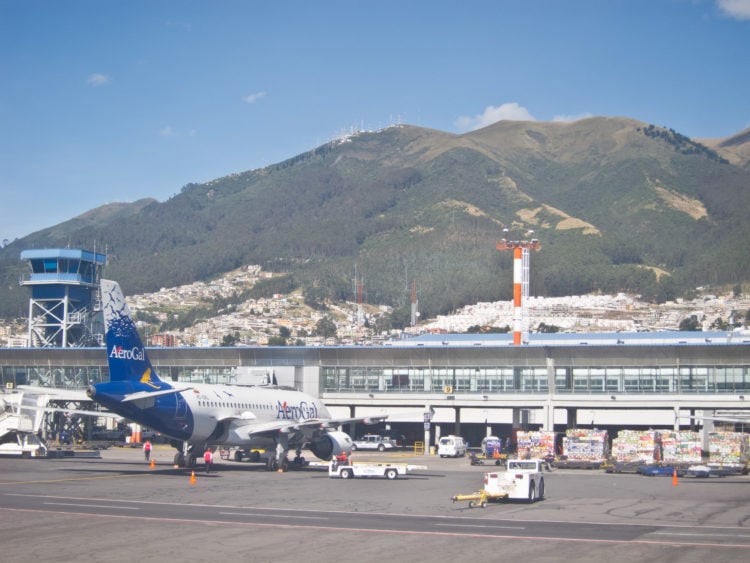
Aeropuerto Internacional Mariscal Sucre
Table of Contents
Getting There & Away
By Air
The Aeropuerto Internacional Mariscal Sucre (UIO) is the main airport serving Quito.
Due to the location within the city, and mountains, the approach to landing requires a series of banks and turns.
A new, larger international airport is currently under construction north of the city.
This airport is the hub for Aerolineas Galapagos and offers daily flights to most of North and Latin America, as well as major European cities.
A taxi during the day costs $5 – 7 to La Mariscal, the main tourist neighborhood. For safety reasons, I advise you to take a cab while carrying all your luggage.
However, if you want to take the local bus, the cost is only $0.25, and you can pick up any “JL Mera” labeled bus by crossing the street outside the Departure area of the airport terminal.
Be sure and keep any bags with valuables on your lap at all times, or in front of you if you're standing. Theft on buses in Ecuador is a problem.
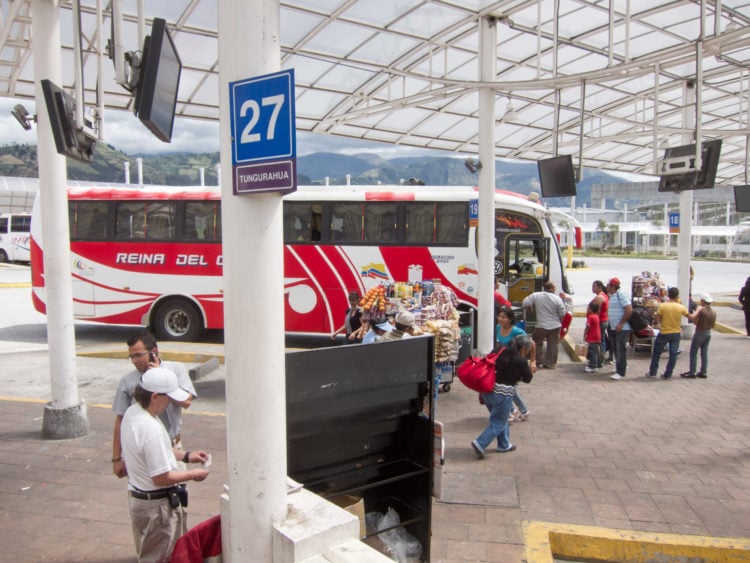
The modern, Terminal Quitumbe in the South of Quito
By Bus
Due to Quito's sheer size, there are two bus stations located at opposite ends of the city.
Terminal Quitumbe
This modern, new bus terminal is located at the Southern end of Quito and services the most common tourist destinations, including the coast (Guayaquil), Amazon, and most of the mountain regions (including Banos and Cuenca).
A taxi during the day from La Mariscal costs about $14, or you can take local buses, however, be extra careful of your belongings.
Buses depart for cities around the country day and night; the bigger the city, the more frequent the departures.
Terminal Carcelén
Located in the Northern part of Quito, this station serves Carchi and Imbabura. The primary reason for taking a bus from this station is to visit the Otavalo Market.
A few bus companies have terminals located in La Mariscal, so you may want to ask at your hostel whether you can take a bus from there; however, you may have fewer departure times and destinations to choose from.
Check out my tips for staying safe on the buses if you want to know the common tactics of thieves, and how to protect yourself.
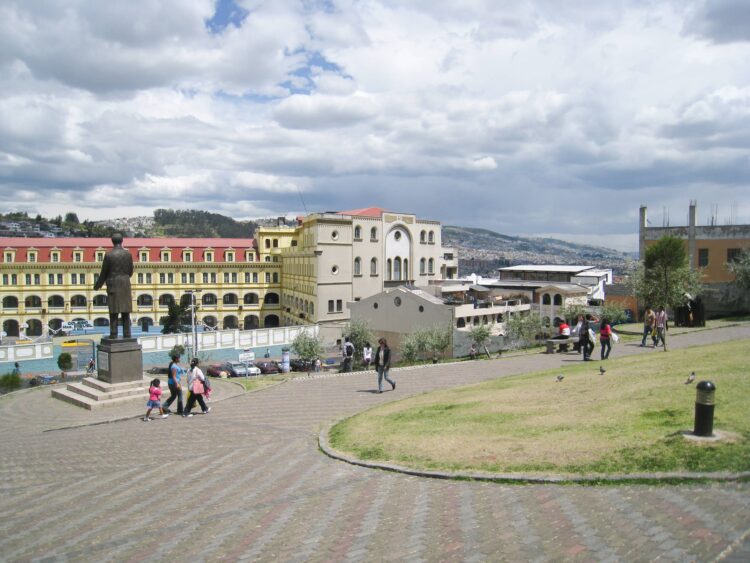
Near Quito's historic center
Getting Around Quito
By Foot
The only areas of Quito you'll want to walk on foot are La Mariscal and the historic city center.
Otherwise, for safety reasons and time, you'll want to take the buses, if not taxis at least, to get around.
By Uber
Uber is the safest way to get around Quito, and it's inexpensive too. Use this ride-hailing app whenever possible.
By Taxi
Taxis are cheap and should be taken at night if you need to go more than a few blocks.
Taxis are metered, though many drivers prefer to negotiate instead, to gauge unsuspecting tourists.
Get an estimate from a local, and always do your negotiating before you enter a cab.
Whenever possible, use a private (yellow) taxi service. Ask your hostel or hotel to call.
Unofficial taxis are much more prone to robberies, whether by the driver or someone else.
A common tactic is the “express kidnapping,” which involves taking the victim to an ATM where they're forced to withdraw the maximum amount allowed.
Sample Costs
- $2 – ride within La Mariscal
- $3 – daytime ride between La Mariscal and historic city center
- $7 – daytime ride between Mariscal Sucre airport and La Mariscal
- $14 – daytime ride between La Mariscal and southern bus terminal
By Bus
There are three private bus systems which ply the city from North to South: El Trole (green stations), Metrobus (blue buses and stations), and Ecovia (red buses and stations).
Most rides cost a mere $0.25, so it can be a very inexpensive way to get around the city.
I know I've already mentioned it often, but be very careful about pickpockets when riding the buses in Quito, and Ecuador.
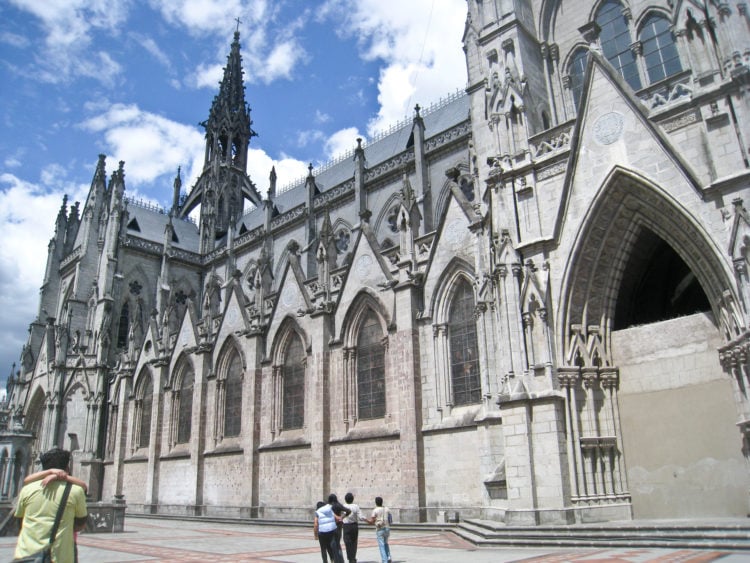
Basilica del Voto Nacional
Tips for Acclimatizing
Visitors arriving by air should expect to feel the physical effects of the high altitude within 24 hours of arrival, including:
- Shortness of breath while walking (especially uphill or climbing stairs)
- Headache
- Loss of appetite
To minimize the effects and their duration:
- Drink LOTS of water (rule: 1 liter per 1,000 meters of elevation, per day)
- Abstain from alcohol and caffeine
- Get plenty of sleep
- Plan to have a relaxing first day (it's essential to get some light exercise, not just sit around or sleep all day)
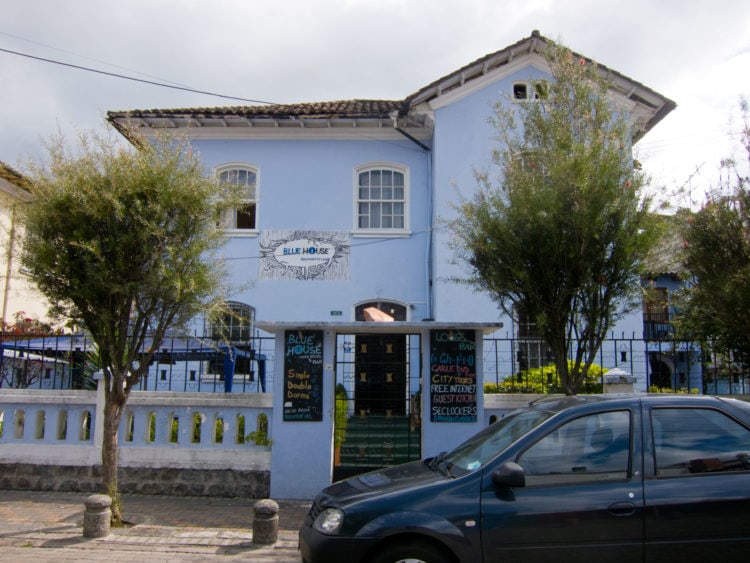
The Blue House in La Mariscal
Where to Stay
Despite the immense and sprawling size of this 2-million person city, most visitors stay in one of two locations: La Mariscal (New Town), or the historic city center (Old Town).
Both locations offer plenty of hostels, restaurants, and tour offices, however, La Mariscal is also the city's Zona Rosa (central nightlife district).
Neither area is especially safe, as backpackers are commonly robbed day and night, within blocks of their hostels.
Hostels
Quito offers backpackers a wide range of accommodation, for all budgets. Costs are higher here than in the rest of the country.
Dorm beds are $10 or less, with private rooms starting around $15 per night.
Quick Recommendations
- Quiet Night — Quito Guest House with Yellow Balconies
- Social Atmosphere — Mogens Pod Hostel
- Partying — Community Hostel
- Amenities — El Hostelito
- City Entertainment — Secret Garden Quito
- Cheap Stay — Home of David’s Friends
See also: Best Hostels in Quito
Short Term Housing
If you plan to spend a few weeks, or months, in the city, then you'll want to rent a room or apartment.
Your best bet is to either negotiate a long term rate with a hostel or use Airbnb.
Couchsurfing
Quito offers plenty of Couchsurfing options.
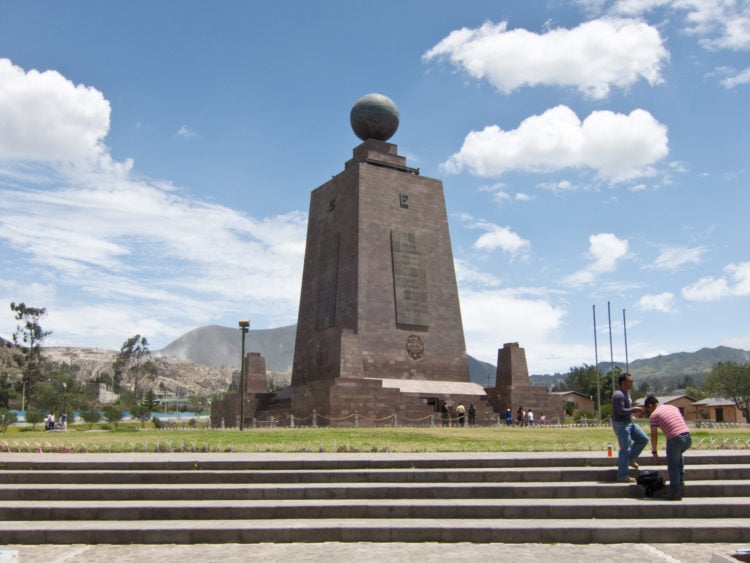
Mitad del Mundo (monument built 100m from the actual Equator line)
Things to See & Do
Even if your time in Quito is short, as is the case with many who only visit Ecuador for the Galapagos Islands, there are still some quick and cheap sightseeing options.
Climbing Pichincha Volcano – If you want to hike to the top of this 4,784-meter volcano, start with an early morning ride on the Teleferico to give yourself plenty of time.
Even if you've spent a few days acclimatizing in Quito, this is a challenging hike.
Mitad del Mundo (Monument at the Equator)
Visiting the official Equator line and the monument built at the wrong spot are Quito's most famous, and popular, sightseeing activity. Allow a half-day.
Riding the Teleferio– For $8.50, you can ride one of the world's highest aerial gondolas. You'll be dropped off at an elevation of 4,100 meters, and offered sweeping, scenic views of Quito and the surrounding mountains.
Go in the morning, when you've got a better chance of clear weather, and dress warmly.
Walking the Historic City Center – A UNESCO World Heritage Site, Quito's city center features a mix of old world museums, churches, and cathedrals. Highlights include:
- Basilica del Voto Nacional
- Plaza de la Independencia
- Church of La Compania de Jesus
- Church of San Francisco
- Museo del Banco Central
The city center can be covered in a half-day, but it's better to allow yourself a full day to see everything at a relaxed pace.
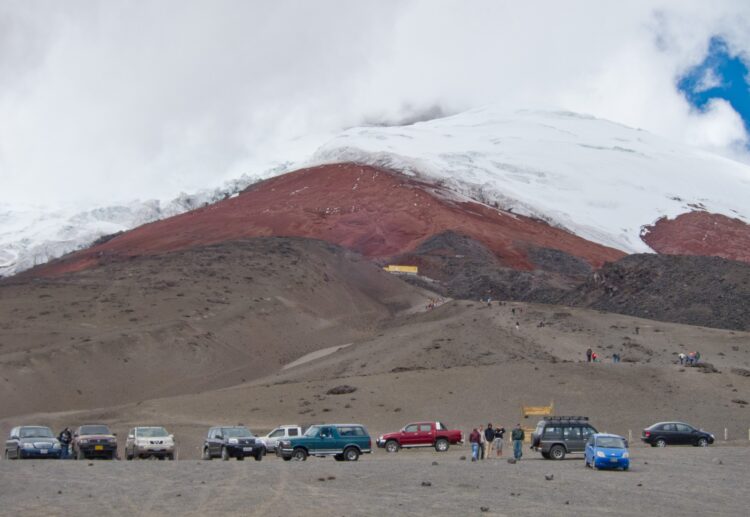
The parking lot at Cotopaxi Volcano – 4,500 meters above sea level
Outside the City
Mountain Biking Cotopaxi Volcano – For active travelers, downhill mountain biking Cotopaxi is one of the best ways to spend a day outside the city.
Alternatively, you can do the one hour hike up to the glacier, or try to summit the near 6,000-meter volcano with an ice ax and crampons over two nights.
Otavalo Market– Ecuador's largest craft market is located two hours North of Quito by bus. Visits can be done in a single day, or you can choose to spend a night or two for a more relaxed experience.
Saturdays are the busiest day. You can go independently, or join an organized group tour from Quito.

Coca leaf tea
Food & Drink
Ecuadorian food doesn't get a lot of attention; however, if you're willing to experiment with new dishes, you're sure to find a few to your liking.
Quito, like Guayaquil, offers a more international selection of restaurants than other parts of the country.
In both cities, you'll find regional dishes from around the country, though there's a more significant emphasis on food from the Sierra in Quito, whereas Guayaquil has a stronger focus on seafood.
Dozens of these restaurants can be found in La Mariscal, centered around Plaza Foch. Expect higher prices given the higher density of tourists.
Regional Dishes
- Caldo de Manguera – Bull penis soup. Aside from the virility benefits, it's thought to be a good cure for hangovers.
- Caldo de Patas – Cattle hoof soup.
- Guayllabamba – A locro-style soup that also includes pork.
- Llapingachos – Cheesy potato cakes.
- Locro – Hearty, cream soup with potatoes, cheese, and a slice of avocado thrown in. An excellent option for vegetarians.
- Yaguarlocro – A locro-style soup with blood sausage and tripe.
Restaurants
Restaurants listed here, and on sites like TripAdvisor, are going to be priced for tourists.
To eat cheaply, including set lunches for as little as $1.50 or $2, look for where the locals are hanging out.
These small, unimpressive restaurants are often just a few blocks from the tourist ones.
Fried Bananas – Mariscal Foch E4-150 y Amazonas, La Mariscal. Typical and cheap Ecuadorian food a few blocks from Plaza Foch.
Magic Bean – Calle Foch 681 y Calle Juan Leon Mera, La Mariscal. Popular with tourists, the Magic Bean serves up decent renditions of Western comfort food and an array of fresh fruit juices.
Uncle Ho's – E-40 Jose Calama y Diego de Almagro, La Mariscal. Known for its Asian cuisine, including Thai and Vietnamese dishes, this well-known restaurant also serves up traditional Ecuadorian food.
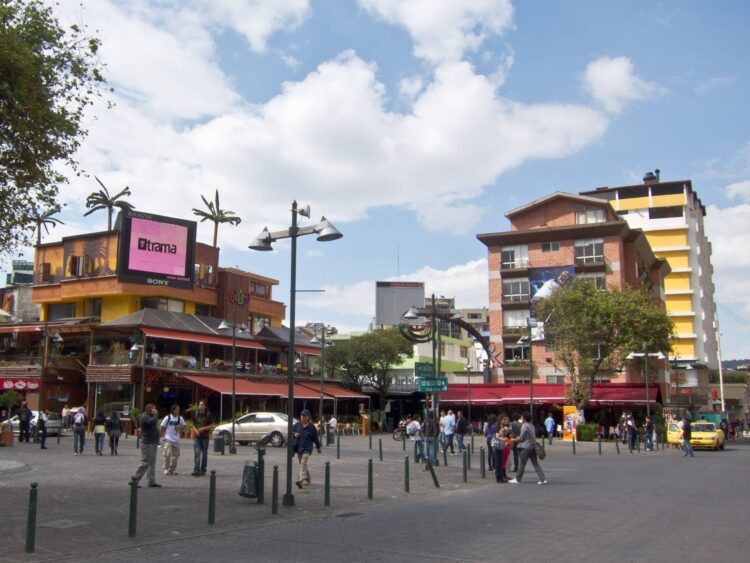
Plaza Foch is the epicenter of nightlife in Quito
Nightlife
Plaza Foch is the epicenter of nightlife in Quito, and the first place most visitors will go out for drinks upon arriving in the city.
As is typical of nightlife in Ecuador, weeknights are low key.
On the weekends, you can party late into the night and any of the nearby bars and discotecas, but be careful about walking home intoxicated.
Stick to a group if walking, and take a cab if you're a woman, or going back to the hostel alone.
Last Updated on August 29, 2019 by Dave Lee
Dave is the Founder and Editor in Chief of Go Backpacking and Feastio. He's been to 66 countries and lived in Colombia and Peru. Read the full story of how he became a travel blogger.

Ursula Staddelmann
Thursday 21st of June 2018
Very good information about how to get around Quito and Ecuador, is always good to know about this things. I was in Ecuador last month and had a great experience in this country. In case you need more information and professional and friendly people to travel Ecuador yo can visit Gulliver Expeditions (www.gulliver.com.ec) they are in La Mariscal area. Very reccomend it.
Ursula
Natalie Bruce
Friday 17th of February 2017
I will be flying into Quito on September 1st at 9:55pm and would like to take a taxi to the South Terminal Quitumbe. are taxes available that late at night?
Dave
Friday 17th of February 2017
I'm going to take an educated guess and say yes. I've never been to an airport that hasn't had taxis available regardless of the time of day, and 10pm isn't that late. I think you'll be fine.
Joel
Sunday 13th of December 2015
Hi there, I arrive in Quito in January 2016, I don't know much spannish, so I plan to book my self into a spannish school. Would you book yourself into a spannish school when you get there or would you book into one before you actually arrive.
Oliver
Monday 16th of November 2015
Good information, but some of it will strike unnecessary fear into first time travellers. Ecuadorian buses really are not as bad as you make out, Peru is much worse. Just keep an eye on your luggage. Also, if you're paying 14usd from Quimbote terminal to mariscos you're getting ripped off. 8 usd is more accurate
Dave
Tuesday 17th of November 2015
I certainly don't want to scare people away from visiting Quito or Ecuador, as I had a wonderful two months in the country.
All I can say is I found a lot of mentions online back in 2011 of bag slashings and robberies on buses, as well as having a friend who used to guide tours in Ecuador have thousands of dollars in photography gear stolen from beneath his nose on a Quito bus.
I felt more comfortable traveling on intercity buses in Colombia, Peru, Chile, and Argentina, which is not to say theft doesn't happen in those countries as well.
Erik
Thursday 8th of October 2015
Hi, I am a senior traveller from Belgium. Sat; Oct 10 I will arrive in the afternoon by plane in Quito. I booked accomodation in Secret Garden. They proposed to collect me at the airport for $ 28 and I think it's too much. So I prefer to take the bus to the hostel. As you write, I will cross the exit gate of airport and take a bus but to which busstation ???
Dave
Thursday 8th of October 2015
I don't know. I don't recall where I found that information, and I took a taxi.